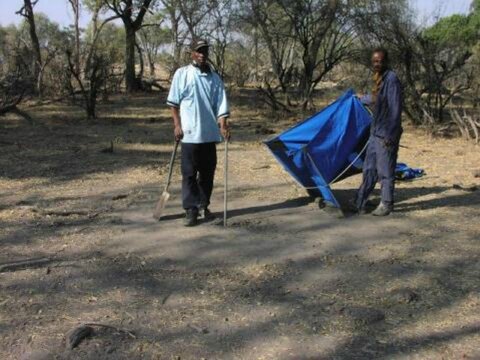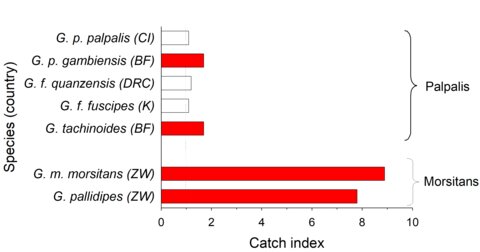Do I need to use attractants with a tsetse trap?

It depends which species of tsetse you are trying to catch.
The benefit of baiting traps with other attractants varies between species. On the one hand, the catches of G. fuscipes of the palpalis group (riverine), are not increased by odour attractants and so there is little point in using them (Omolo et al 2009). Whereas trap catches of G. gambiensis and G. tachinoides, also palpalis group species, can be doubled with the addition of ox odour (Rayaisse et al 2010).

On the other hand, the morsitans group of flies, such as G. pallidipes, are very responsive to odours (as shown in the figure above), and catches can be increased fourfold by baiting traps with a blend of acetone, 1-octen-3-ol, 4-methylphenol and 3-n-propylphenol. Between these two extremes lie species that only respond to certain chemicals (see Table 2, Gibson & Torr, 1999).
Look at the table on the right to see which species responds to which chemical. Tsetse Plan uses these data to tell you which chemicals you should use for operations in your area.
There has not been a thorough test of the responses of all species of tsetse to the various attractants. If there is no information on what chemicals you should be using for your local species of tsetse, then it's probably best to bait survey traps with the complete blend that is effective against G. pallidipes.
If you are thinking of using large numbers of odour-baited targets to control tsetse then you will need to be sure which chemical you should be using; you wouldn't want to waste money on unnecessary chemicals. So if this is the case, then you should think about carrying out experiments to test which attractants are effective for tsetse in your area. Tsetse Plan provides advice on how to plan and analyse experiments to do these simple investigations.
References
Omolo, M.O., Hassanali, A., Mpiana, S., Esterhuizen, J., Lindh, J., Lehane, M.J., Solano, P., Rayaissse, J.B., Vale, G.A., Torr, S.J. & Tirados, I. (2009). Propects for developing odour baits to control Glossina fuscipes spp., the major vector of human African trypanosomiasis. PLoS Neglected Tropical Diseases, 3 (5), e435.
Rayaisse, J.B., Tirados, I., Kaba, D., Dewhirst, S.Y., Logan, J.G., Diarrassouba, A., Salou, E., Omolo, M.O., Solano, P., Lehane, M.J., Pickett, J.A., Vale, G.A., Torr, S.J., Esterhuizen, J. (2010). Prospects for the development of odour baits to control the tsetse flies Glossina tachinoides and G. palpalis s.l.. PLoS Neglected Tropical Diseases, 4.
Gibson, G. & Torr, S.J. (1999.) The responses of haematophaous Diptera to physical and olfactory host stimuli. Medical and Veterinary Entomology 13, 2-23.